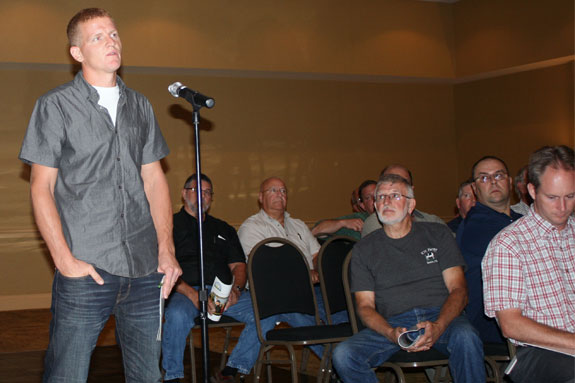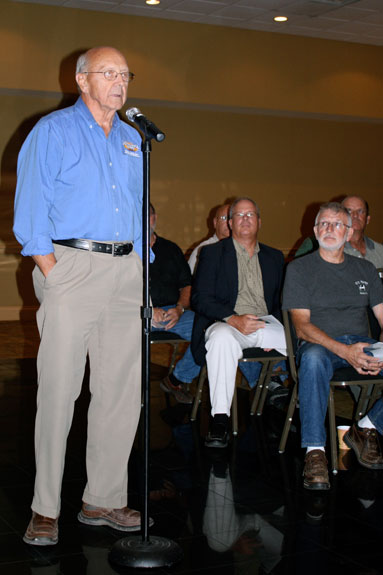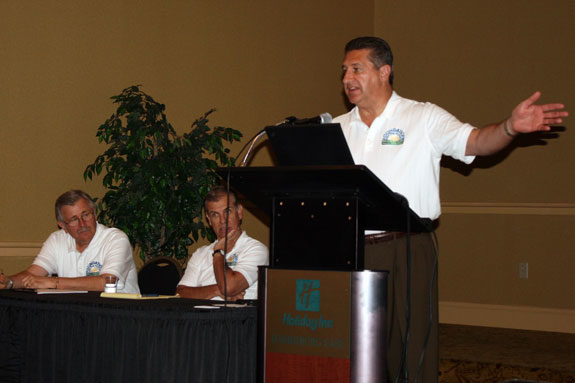The Foundation for the Future (FFTF) plan proposed by the National Milk Producers Federation (NMPF) took another step towards becoming the nation’s next avenue for dairy policy reform. On July 13, House Agriculture Committee’s Ranking Member Collin Peterson (D-Minnesota) released draft legislation incorporating the key elements of the plan into his legislative proposal. At the same time, NMPF staff members hit the road on a six-week cross-country tour to reach out to dairy producers about the benefits of the reforms contained in FFTF.
President and CEO Jerry Kozak, along with senior staff members Jim Tillison and Jaime Castaneda, planned to host three-hour sessions in 12 cities across the country in July and August.
Progressive Dairyman met up with the tour July 21 in Dubuque, Iowa, and August 8 in Harrisburg, Pennsylvania. to read about the question and answer session from Iowa, and to read about the session from Pennsylvania.
The first half of the meeting detailed the plan, which, in summary, eliminates the Dairy Product Price Support Program and the MILC while establishing a Dairy Producer Margin Protection Program, as well as a Dairy Market Stabilization Program. It also reforms existing federal milk marketing orders.
“It’s not perfect,” Kozak admitted, adding, “The most perfect program isn’t necessarily the one that can get through Congress and maintain the kind of consensus we need, especially on the producer side, and that’s what this program is about.”
He reported that the Congressional Budget Office (CBO) has scored the discussion draft, and it shows a $166 million savings compared to the present baseline over a five-year period.
“FFTF was scored with enough significant savings that it could move forward,” Kozak said.
However, the CBO did make two changes compared to the original package as proposed by NMPF.
In the Dairy Producer Margin Protection Program (DPMPP), the amount of basic margin coverage has been adjusted from 90 percent to 75 percent of a producer’s production history. However, the supplemental coverage option remains at 90 percent of the producer’s production history.
In addition, CBO determined that 50 percent of any dollars collected as a result of the implementation of the Dairy Market Stabilization Program (DMSP) will be remitted to the Treasury, rather than being spent to purchase dairy products.
Kozak said NMPF is still working through these changes, but does not believe they will hamper the effectiveness of the program.

IOWA
The second half of the meeting was spent taking producer questions and comments from the floor. Here are portions of that discussion.
How would this program work if the supply management portion were removed?
KOZAK: It became apparent to [our board] that the producer support across the country was very strong for having some type of supply management program. Rather than try to fight those [other programs], we took some of the best pieces and we tried to construct a program that really, in many respects, is very benign. It triggers in and triggers out.
The membership considered what happens if we don’t have that as part of the program. It was pretty apparent; you could not get it passed in our own membership without it.
If they pass this thing at 75 percent for your base plan, is that going to force everybody to go into the supplemental plan to get the 90 percent coverage? More so than it did before?
KOZAK: I think the base program is there for the catastrophic issues. But when you have periods of lower margins at longer periods of time, honestly, what we’re hopeful is that most farmers will at least avail themselves of that supplemental coverage to some extent.
Why wouldn’t it be more advantageous to us dairy farmers to support a program where we get money back during low income versus giving half the money to the federal treasury?
KOZAK: You cannot get enough support from the National Milk board and the membership and other groups to have that sort of ‘take the money here and redistribute it’ program. It’s just not the political reality. We designed a route that would be more possible.
On the treasury part, 25 percent of [the 50 percent change] is a CBO rule that applies both to the House and Senate. It says that if you have a program that reduces revenue that the government gets, in this case under a market stabilization trigger, if you were not paid for $5,000 of your milk you wouldn’t have to report that as income.
This law says because you’re not paying taxes on it, you’ve now reduced the taxes that the government collected. They have an automatic rule to take 25 percent of any additional money that’s generated. The other 25 percent is to help offset the federal deficit. We’re working on that.
Would we still have to pay the 15-cent promotion fee, hauling, etc., on the milk that we would not be paid for [if we overproduce while the stabilization program is triggered in]?
TILLISON: Basically if the milk is marketed, the marketer would deduct the 15 cents from the money it sends the government. It would not come out of your check additionally.
How are we going to be informed of supply management restrictions?
CASTANEDA: On the market protection, that’s going to be relatively simple. It is similar to how you sign up for MILC through your FSA office. However, you’re going to have to do it only once; that’s all for four or five years.
On the market stabilization program, the USDA is going to make an announcement through whomever you ship your milk to. They’re going to tell you 30 days in advance that this is coming.
How would this program appeal to legislators from urban districts?
KOZAK: I see an advantage in our ability to augment food banks and other feeding programs through the market stabilization program. The federal government is going to have a hard time doing that in the future.
Isn’t this merely a sophisticated central planning system? You’re taking the market out of it. You’re having a committee dictate what we should and shouldn’t produce. They’re going to take money from us that then goes to the USDA.
KOZAK: Let me make very clear that that board has no authority about how much [milk] can be produced. There were previous proposals that advocated a producer board that would do exactly what you talked about. We knocked that [idea] out.
The dollars will be collected under the present AMS system so we don’t create a new structure. It’s the same as the checkoff dollars. AMS collects those dollars from the handlers if, in fact, they trigger in.
Those dollars are available to the board, not USDA. This board of producers will physically decide what type of products will be purchased and where those products should be sent.
If there’s no mandated market for components, won’t that market go away?
TILLISON: Where there is a value for components, in the Upper Midwest for example, people are still going to get paid for components. That’s not going to go away.
The only thing that’s occurred is that there’s no longer minimum pricing and without minimum pricing it’s difficult to have a minimum component value for protein, for example. Dairy farms are still going to get paid for the value of the milk, if that milk has value to the handler it goes to.
KOZAK: If you’re a Jersey producer in the Northeast where it’s a strictly fluid market, there could be some impact there.
In the economic time that the world is in right now, is this a good time to tie us into a five-year program?
KOZAK: Yes. The margin protection program would be locked in for five years. I don’t see that as problematic because if I know that I’m going to lock in those cheap insurance rates on supplemental for five years, that’s going to help me manage my risk more than anything.
We put in a provision that the market stabilization program should be reviewed in two years because if it’s not working or there are really major problems with it, we wanted to allow for changes to be made.
The program presents stability and growth and, to me, those don’t go together. Do we want stability or do we want growth?
KOZAK: That market stabilization program, as you can see, gives you the opportunity to pick the different base, whether it’s a rolling three-month average or the month of the year prior. When it kicks in, it comes out quickly, and then a new base starts. We tried to design it so that there is growth.
There is a margin protection program available in the private sector. Why does it need to be through the government?
KOZAK: When we began this process we reached out to Bruce Babcock; he owns Livestock Gross Margin Program. We’re advocates of the LGM program, but it’s not for all producers. He recognized that and helped us design our program.
Recently, the CBO scored LGM at $5 billion if it was put in [nationwide]. Then they determined that in order for it to fit within the baseline, only 10 percent of the [milk] production in the entire country would be covered. That’s not a practical program.
Is there language in there that when the five years are over the bases will be updated?
KOZAK: Once this ends, the market stabilization program, as well as the market protection program, would have to be renewed. It’s not permanent legislation. If it continues then the bases would change.
Would the market stabilization portion have been enacted earlier this year?
KOZAK: You’re committed to margin as the vehicle, not price. If the milk price is $20, but the input cost is $17, what’s the difference between that and $12 milk and $9 input costs? Once the organization committed to margin, that’s what it’s all about. It would’ve kicked in. That margin was suppressed even though you had price.
Who’s to say this isn’t going to be shot down by lobbyists influencing Congress?
KOZAK: One of the big advantages that we have is there’s a big difference when that congressman or senator hears from you and your family and your community. The sentiment is there for farmers. Where we implode is when we don’t send a consensus message.
Could we get along without the government being involved?
KOZAK: You couldn’t get an agreement to get the government completely out of our business at the moment. The politicians themselves wouldn’t allow it.

PENNSYLVANIA
More than 130 producers and industry representatives attended the grassroots meeting in Harrisburg, Pennsylvania, which was the highest attendance reported thus far on the tour. Here are portions of the question and answer discussion.
Q. Shouldn't imported milk be cut first?
KOZAK: We're not going to stop imports. It's not going to happen. In the programs we developed, we're trying to offset the imports coming in. In the Market Stabilization Program, if the world price was 20 percent less than the domestic price, it doesn't trigger in because we're not an organization that wants to promote more imports coming in. So we're extremely concerned about it, and we're probably going to tighten that provision. But the fact of it is, and this is something else where people have it wrong, take a look at the numbers. Imports did not cause our problem in 2009.
CASTANEDA: We import only about 3.5 percent, and we export about 15 percent of our production today on solids. And one of the things I thought I'd never say but I've stated at a number of these meetings is: Today a New Zealand dairy farmer, for the most part, is getting a better price than a U.S. dairy farmer. It has to do with how quickly they come out of low margins and low prices. So this is what we're trying to do with this program – to catch up and be in a better position.
KOZAK: We have to think about ourselves in a new world. You first have to think about the fact that the price support program is gone. There is no MILC payment. You have a larger protection program, and the Federal Milk Order is revised, and you have the Market Stabilization Program in effect. What does that mean? I'm not going to stand here and say that you may not get a lower milk price, but if that were to occur, the market is now going to clear. We're actually going to be in a better position to export because instead of mandating that we're now producing milk at a higher volume because we have to, under the present structure, we're producing it at less. And you're protected because you have the Margin Protection Program. The whole dynamics have changed, and imports aren't going to play the kind of role they're playing now because when that market clears, we're going to be exporting more product than we are under this system.
Q. My question is on the Dairy Market Stabilization Program. If I choose not to take the government's money, why must I be forced to give it?
I have never participated in any government programs, crop or milk – and I've survived. I have a big concern when I am asked to trust the government. Love your country, but never trust the government. And now we're going into a program where we're putting them in charge. I know the marketplace is rough sometimes, but I'm willing to take my chances over the government. Freedom is bought with blood, and I won't sell it for a dollar.
KOZAK: I respect your views, and I think most of our members would support that. But the problem is 2009 was so devastating all across the country, and of course we represent a broad swath of people, that's it's pretty hard to gain consensus and just allow the marketplace to work. There's enough people who want some sort of safety net. And I don't think there's a lot of government intrustion there. The only thing that government does is mandate. They can't decide those margins are $6, $5 and $4 today and something different [tomorrow]. It's at least predictable.
This was a concern with the CWT program, which was a voluntary program. After 10 years, we never really got to the point where we minimized the free-rider issue. So there was concern among the producers that there had to be a critical mass, and that's why the Market Stabilization Program is mandatory. But remember, we're a long way from everything getting enacted.
Q. How can you make sure these programs are actually being funded and work?
KOZAK: That's part of the language that we're looking at – to make sure that those programs are funded in this bill, whether it's this bill or the Farm Bill, so that FSA can do what their job is supposed to do in terms of the Margin Protection Program. On the Market Stabilization Program, the way we have structured this is we don't create a new bureaucracy because that's not what we're about either. AMS, which is already collecting the 15 cents – that framework is in place for the market administrators and handlers to report that – there's not that much of a problem administratively to do that piece when [the program] triggers in. We are making sure that these are not unfunded mandates.
Q. In the last couple of months, there have been two national breed organizations that had conventions, and both of them have failed to endorse this program. Why?
KOZAK: I was the keynote speaker at the Holstein's convention in Virginia, and we had very good dialogue. Their legislative committee met. I think the mitigating factor for them is they want to raise the margin in the Market Stabilization Program from $6, $5 and $4 to $7, $6 and $5. With all due respect, we already have tremendous amount of people who have concerns about the Market Stabilization Program, so raising margins in that program is very unrealistic. We have to have a program that can get passed. So I'm optimistic that when their board of directors meets in September, they're going to review that.
The other issue that they had was using formal rule-making to conduct the Federal Milk Marketing Order. That's problematic because we spent two years getting agreement within the National Milk membership, eliminating minimal pricing for Class II, III and IV. Quite candidly, there's a lot of concern that just turning it over to USDA, given the track record that we've experienced, is not the best way to go.
On National All-Jersey, we've given them the opportunity to take a look at helping us on the component pricing issue. There's another case where it's easy to say you don't like something, but it's another thing to sit down and pen and pencil it out, and help us. I'm optimistic that those two organizations are going to support the program, once we've worked out some of those issues. PD

-
Karen Lee
- Progressive Dairyman Midwest Editor
- Email Karen Lee

-
Emily Caldwell
- East Coast Editor
- Email Emily Caldwell







